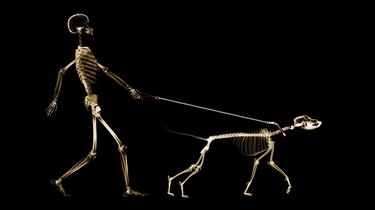Things You'll Need
4 binding wires
Air drying modeling clay
Illustration of skeleton
Rounded end clay modeling tool
Clay carving tool

Clay is a versatile substance that can be used to make a variety of objects. The pliability of clay allows modelers to shape it into any structure, such as a skeleton, on around a wire framework, or armature. Any skeleton can be shaped from clay. Paleontologists often use clay to reform missing bones from dinosaur skeletons. To create any skeleton, you will need a list or a depiction of the actual skeleton indicating which bones go where.
Make a Human Skeleton
Step 1
Twist four binding wires together. Separate two wires and bend each in opposite directions to make arms. On the opposite end, divide the four wires into two sets for legs. This should leave two wires twisted together, pointing straight up.
Video of the Day
Step 2
Break off a small portion of clay to ball between the palm of your hands. Use your thumb and index finger to press and shape the ball into a skull. Use a round-ended clay shaping tool to create eye, ear and nose sockets. Carve a line from ear socket to ear with the carving tool. Carve small squares on either side of the line to represent teeth. Set the skull onto the two wires pointing straight up.
Step 3
Break off small pieces of clay and roll between your thumb and index finger to form ribs and other bones such as femur, tibia, humerus ulna, collar bone and radius. Shape the bones to flare at the ends where the joints connect. Press each bone into the spot along the wire structure. The wire should be exposed in some places, especially between the leg and arm bones.
Step 4
Shape the pelvic bones and sternum. Press the sternum below the arm intersections. Press the pelvic bone into place at the point where the legs split.
Step 5
Roll a long piece of clay for the spine. Shape tiny little lengths of invertebrates. Press the clay down the length of the structure.
Step 6
Create hands and feet by flattening out four oval shapes. Carve the shape of finger and toe bones (tanges and phalanges). Attach the feet to the bottom of the leg wires and the hands to the ends of the arm wires.
Step 7
Allow the clay to dry.
Video of the Day